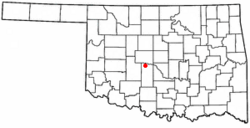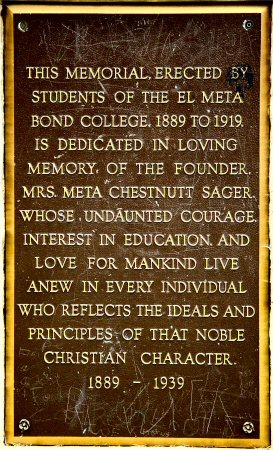Minco, Oklahoma facts for kids
Quick facts for kids
Minco, Oklahoma
|
|
|---|---|
| Nickname(s):
The Land of Milk and Honey
|
|

Location of Minco, Oklahoma
|
|
| Country | United States |
| State | Oklahoma |
| County | Grady |
| Area | |
| • Total | 12.31 sq mi (31.88 km2) |
| • Land | 12.28 sq mi (31.79 km2) |
| • Water | 0.04 sq mi (0.09 km2) |
| Elevation | 1,309 ft (399 m) |
| Population
(2020)
|
|
| • Total | 1,500 |
| • Density | 122.19/sq mi (47.18/km2) |
| Time zone | UTC-6 (Central (CST)) |
| • Summer (DST) | UTC-5 (CDT) |
| ZIP code |
73059
|
| Area code(s) | 405 |
| FIPS code | 40-48750 |
| GNIS feature ID | 2411117 |
Minco is a city in Grady County, Oklahoma, United States. In 2020, about 1,500 people lived there. This was a small decrease from the 2010 population.
Contents
Minco's History
Minco started as a settlement called Silver City. It was located on the famous Chisholm Trail. This trail was used to move cattle across the country. Silver City was a collection of tents where different Native American tribes lived. These included the Caddo, Wichita, Kiowa, and Comanche tribes.
From Silver City to Minco
The town moved when the Rock Island railroad built tracks to the Chisholm Trail. The new town was built at the end of the railway line. It was then renamed Minco. The name Minco is thought to come from Itawamba Minco. He was a great Chickasaw chief and warrior.
Minco was officially settled around 1890. This was several years before Oklahoma became a state. The town's post office opened in July 1890. Minco was a very busy place at first. This was because it was at the end of the Chicago, Rock Island & Pacific Railroad. Two years later, the railroad was extended further south.
Charles B. Campbell owned the land where Minco was built. His wife, Maggie Williams, was the daughter of W. G. (Caddo Bill) Williams. Caddo Bill started Silver City in 1872. He built a trading store for cattle drivers on the Chisholm Trail.
Early Explorations in the Area
Before Minco became a town, explorers passed through the area. In 1849, Captain Randolph B. Marcy led an expedition. He was guiding 1,500 people heading to the California Gold Rush. They named a creek "Deer Creek" as they passed through.
In 1853, Lieutenant Amiel Weeks Whipple surveyed the area. He was looking for a railroad route from Fort Smith to Los Angeles. His route followed Marcy's for a while.
Railroad and Growth
The Rock Island Railroad wanted to ship cattle from the Chickasaw Nation. Minco became a key point for this. On August 4, 1901, the Chickasaw Nation's land was opened for settlement. This made Minco an important railroad center for the whole area.
In October 1901, local people formed a company. They sold empty lots to encourage more people to settle in Minco. This company was called the Minco Townsite and Investment Company.
Minco was one of the oldest towns in western Oklahoma. Its businesses served people from many miles around. A hardware store that opened in 1891 is still there today. Some old hotel buildings can still be seen on Main Street.
El Meta Bond College
In 1894, Meta Chestnutt came to Minco from North Carolina. She wanted to bring education to the frontier, especially for Native Americans. With J.H. Bond, she started the El Meta Bond College. This was one of the first colleges in the area.
The college taught elementary, grammar, and high school subjects. It also offered music and drama classes. The college faced money problems. It closed in 1920 because fewer students enrolled. New schools opened after Oklahoma became a state.
The old college building was taken down. A new armory was built in 1936. Today, it is a community center. A park is also on part of the old campus. There is a plaque in the park. It honors Meta Chestnutt for her work.
Modern Developments
In 1960, Minco started Oklahoma's first city-owned natural gas company. James Burton Branum, Jr. founded it.
In 2007, the Minco Historical Society opened a museum. It shows many historical facts about the town.
Minco's Geography
Minco is located in the northern part of Grady County. The city's northern border is the Canadian River. This river also separates Minco from Canadian County.
U.S. Route 81 goes through the middle of Minco. It goes north 16 miles to El Reno. It goes south 19 miles to Chickasha. Chickasha is the county seat of Grady County.
Oklahoma State Highway 37 also passes through Minco. It goes east 8 miles to Tuttle. It goes west 10 miles to Cogar. Oklahoma City is about 35 miles northeast of Minco.
In 2010, Minco covered about 12.3 square miles (31.9 square kilometers). Most of this area is land. Only a small part is water.
Minco's Population (Demographics)
| Historical population | |||
|---|---|---|---|
| Census | Pop. | %± | |
| 1910 | 706 | — | |
| 1920 | 606 | −14.2% | |
| 1930 | 962 | 58.7% | |
| 1940 | 921 | −4.3% | |
| 1950 | 978 | 6.2% | |
| 1960 | 1,021 | 4.4% | |
| 1970 | 1,129 | 10.6% | |
| 1980 | 1,489 | 31.9% | |
| 1990 | 1,411 | −5.2% | |
| 2000 | 1,672 | 18.5% | |
| 2010 | 1,632 | −2.4% | |
| 2020 | 1,500 | −8.1% | |
| U.S. Decennial Census | |||
In 2000, Minco had 1,672 people living there. There were 658 households. About 36% of households had children under 18. Most households (59.7%) were married couples.
The population was mostly White (91.99%). Some residents were Native American (3.11%). About 3.47% of the population was Hispanic or Latino.
In 2000, about 29.1% of Minco's people were under 18. About 15.7% were 65 or older. The average age was 36 years.
Minco's Economy
Farming and Honey
A sign at the edge of Minco says, "Welcome to Minco, The Land of Milk and Honey." This is because the town has many dairy farmers. It also has Oklahoma's largest beekeeping company, Gibson-Ross Clover Bloom Honey.
Every first Saturday in December, Minco hosts the Christmas Honey Festival. Thousands of tourists visit. Jim Ross, who owns Ross Honey Company, gives tours. He shows how honey is made.
Electric Power
In 2012, construction started on wind farms near Minco. These are called Minco I, Minco II, and Minco III. By 2017, these wind farms made 300 megawatts of electricity. Some of this power goes to Google's facility in Mayes County, Oklahoma.
Minco's Media
Minco has two weekly newspapers. The Minco Millennium has been published since 1998. It is located on Main Street. The Minco-Union City Times serves both Minco and Union City.
Minco also had newspapers in the past:
- Minco Minstrel, published from 1890 to 1999 (with some breaks)
- Minco Monitor, published from 1892 to 1899
- Minco Weekly, published from 1899 to 1900
- Minco Herald, published from 1916 to 1921
You can find copies of these old papers. They are on microfilm at the Oklahoma Historical Society building.
Notable Person
- Sherri Hill, a famous fashion designer, is from Minco.
See also
 In Spanish: Minco (Oklahoma) para niños
In Spanish: Minco (Oklahoma) para niños


